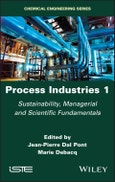Table of Contents
Foreword 1 ix
Laurent BASEILHAC
Foreword 2 xi
Vincent LAFLÈCHE
Foreword 3 xv
June C. WISPELWEY
Introduction xvii
Jean-Pierre DAL PONT and Marie DEBACQ
Chapter 1. Industries, Businesses and People 1
Jean-Pierre DAL PONT
1.1. Manufacturing, process, and service industries 2
1.1.1. Manufacturing industries 2
1.1.2. Process industries 2
1.1.3. Service industries 3
1.2. Founding fathers of the industrial enterprise 3
1.3. Anatomy of an industrial enterprise 4
1.4. Industrial strategy: the business plan 6
1.4.1. Industrial strategy of the company 7
1.4.2. Business plan 10
1.4.3. Reengineering the corporation 11
1.5. Systemic vision of the enterprise: the enterprise and flows 11
1.6. The two operating modes of the enterprise: operational and entrepreneurial 13
1.7. Governance 14
1.8. Operations abroad 15
1.9. References 15
Chapter 2. Earth, Our Habitat: Products by the Millions, the Need for Awareness 17
Jean-Pierre DAL PONT and Michel ROYER
2.1. Population explosion 18
2.2. Systemic analysis and the concept of a system 20
2.3. Earth, a complex system 22
2.3.1. Atmospheric chemistry, ozone, and climate change 22
2.3.2. Water-energy-food-climate nexus 22
2.4. Awareness, sustainable development 26
2.4.1. Rachel Carson and sustainability 26
2.4.2. Sustainable development 27
2.5. Products by the millions 28
2.6. Resource Earth, garbage Earth: towards a circular economy 31
2.6.1. Circular economy 32
2.6.2. Lifecycle assessment (LCA) and ecodesign 33
2.7. Materials science 34
2.8. Product formulation and engineering 35
2.9. Product toxicology and ecotoxicology 36
2.10. Product packaging and ergonomics 37
2.10.1. Packaging and packing/wrapping 37
2.10.2. Ergonomics 37
2.11. New consumer requirements 38
2.12. Boxes 39
2.13. References 83
Chapter 3. Designing Chemical Products 85
Willi MEIER
3.1. Introduction 85
3.1.1. Why is chemical product design important? 85
3.1.2. Current state of the art 87
3.2. Basic technologies 88
3.2.1. Dimensions 88
3.2.2. Additives 89
3.2.3. Microencapsulation 94
3.3. Products 97
3.3.1. Aspirin® 97
3.3.2. Coffee and related beverages 99
3.4. Product design 4.0 103
3.5. References 105
Chapter 4. Chemical Engineering: Introduction and Fundamentals 107
Marie DEBACQ, Alain GAUNAND and Céline HOURIEZ
4.1. Introduction: definitions, history, and challenges 107
4.1.1. Prehistory of chemical engineering 108
4.1.2. A crosscutting science serving society 109
4.1.3. Chemistry, formulation, industrial chemistry, chemical engineering, and product engineering 110
4.2. Fundamentals of chemical engineering 114
4.2.1. Thermodynamic fundamentals of chemical engineering 114
4.2.2. Kinetic fundamentals of process design 126
4.2.3. System-balances-performance approach for process design 145
4.2.4. Conclusion: ideal hydrodynamics and balances 152
4.3. Box 154
4.4. References 155
Chapter 5. Chemical Engineering: Unit Operations 157
Marie DEBACQ
5.1. Distillation 159
5.1.1. Vapor-liquid equilibria 162
5.1.2. Balances for a distillation column 164
5.1.3. McCabe-Thiele method 165
5.1.4. Technologies for continuous distillation 167
5.1.5. Conclusion on distillation 168
5.2. Fluid-solid mechanical separations 169
5.2.1. Fluid-solid interaction laws 169
5.2.2. Settling 173
5.2.3. Centrifugal and inertial separation 174
5.2.4. Filtration 177
5.2.5. Conclusion on fluid-solid mechanical separations 182
5.3. Stirring 183
5.3.1. Qualitative aspects of stirring 184
5.3.2. Quantitative aspects of stirring 186
5.3.3. Choice of impellers 188
5.3.4. Stirred tank scale-up 189
5.3.5. Conclusion on stirring 190
5.4. Heat exchangers 190
5.4.1. Heat exchanger technologies 190
5.4.2. Designing heat exchangers 192
5.4.3. Conclusion on heat exchangers 195
5.5. Reactors 195
5.5.1. Conversion rate and generalized extent of reaction 196
5.5.2. Ideal homogeneous reactors 198
5.5.3. Non-ideal reactors 203
5.5.4. Multi-phase reactors 205
5.6. Conclusion 208
5.7. Boxes 209
5.8. Glossary 223
5.9. References 224
List of Authors 227
Index 229
Summary of Volume 2 231








